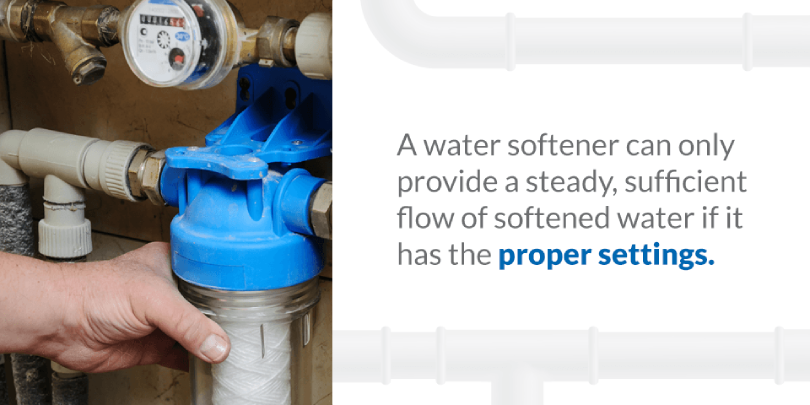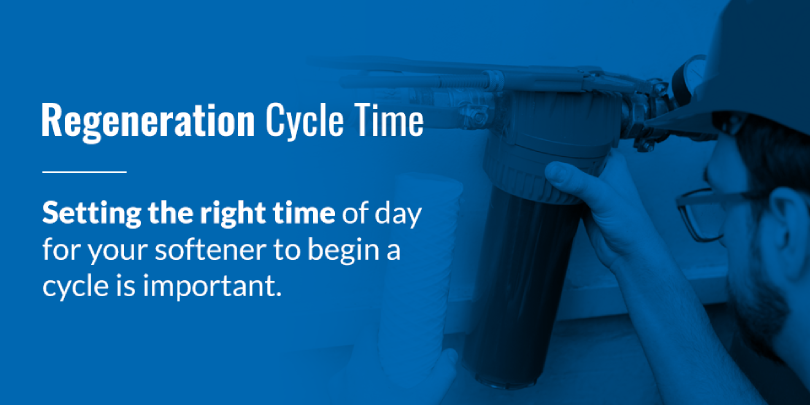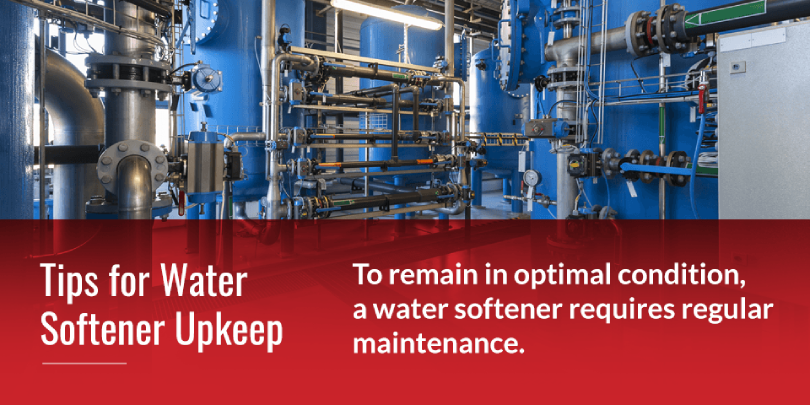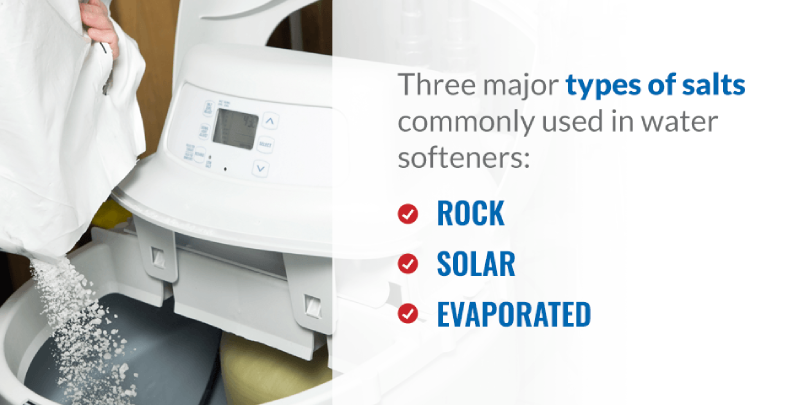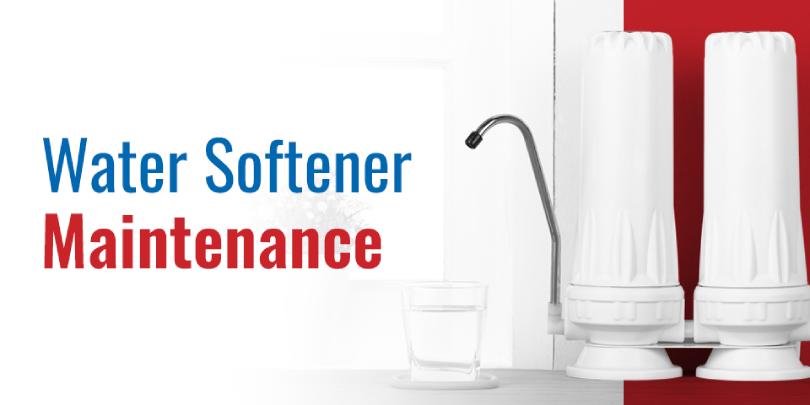
In many parts of the country, a water softener is a vital piece of home equipment.
"Hard" water is filled with mineral ions, most commonly magnesium and calcium. While a high mineral content is not necessarily harmful to human health, these concentrated ions can damage plumbing lines. Over time, calcium and magnesium deposits can block pipes, hurt water heaters and decrease the effectiveness of water-soluble cleaners such as detergents and soaps.
This is where a water softener is helpful. Using ion exchange, a water softener removes calcium and magnesium from water, resulting in "soft" water. When hard water enters a water softener, it first passes through a tank containing resin beads. Oversaturated with sodium, the resin beads bind to the mineral ions, swapping magnesium and calcium for sodium. Free of harmful minerals, the output water is considered soft and safe to enter the plumbing lines.
Routine upkeep will make your water softener work more efficiently and last longer. However, for the best results, have an expert perform an annual inspection on the equipment — regular servicing will not only extend the life of your water softening system, but it also has the potential to lower any future repair costs.
What Is Water Softener?
A water softener is a filtration system that rids hard water from its buildup of calcium and magnesium. The system is connected to a plumbing source in your home. After filtering out the harsh chemicals that affect the water in your home, soft water will stream out of your appliances and faucets.
How Do Water Softeners Work?
Water softeners consist of two tanks, the main tank and the brine tank. In the main tank, there are tiny resin beads that act as a magnet for calcium and magnesium. The hard water filters through the main tank, resulting in soft water that is pumped out of your home’s plumbing.
With prolonged use, the main tank builds up harsh chemicals — then the brine tank comes into play. The brine tank is filled with salt water that flows through the main tank, flushing out the buildup and letting the resin beads get back to work.
Important Water Softener Settings
A water softener can only provide a steady, sufficient flow of softened water if it has the proper settings.
Water softeners have four basic settings — regeneration cycle frequency, regeneration cycle time, regeneration cycle length and salt dose. Most of the settings revolve around the regeneration process, which is a critical stage in the water softening process.
Once the resin beads exchange ions with hard water, they take on minerals. Before a new wave of hard water can enter the system, these beads must be "regenerated" — they must swap out calcium and magnesium ions for sodium once again, so they can repeat the softening process with the next batch of water.
A second container called the brine tank is responsible for sending a wave of sodium-filled water over the resin beads. In the brine tank, water is mixed with high amounts of salt to create a brine solution. When exposed to the brine, the resin beads swap their mineral ions for sodium ions, making them ready to begin the softening process with a new flood of hard water.
The perfect frequency, timing and duration of the regeneration cycle varies based on every household's schedule and water hardness. However, below we have briefly explained what each setting means, so you can find the best balance for your situation.
1. Regeneration Cycle Frequency
The first major setting on your water softener is the regeneration cycle frequency.
Typically, regeneration cycles are manually set for anywhere from one to seven times per week — as long as your water is not getting hard between cycles, anytime within this frame is generally acceptable. You can determine the best frequency for your softener and water by the amount of water used in your home, the number of contaminants or minerals in your water and the size of your water softener.
However, if you have set your softener's regeneration cycle to once a day and notice that your water is still hard, the problem might not be the frequency of the cycle. Try increasing the levels of salt in the brine tank — your resin beads might not be receiving enough sodium to regenerate fully.
2. Regeneration Cycle Time
Another important setting is the time of the regeneration cycle.
Setting the right time of day for your softener to begin a cycle is important. First, it affects the amount of water output — during a regeneration cycle, the water softener will not provide any new softened water. Additionally, a water softener may make loud noises during a regeneration cycle. If you schedule a regeneration cycle during the night, the sounds might keep you or your family awake.
For the best results, try to schedule a regeneration cycle during a time when your household will not use much water and will not be disturbed by the potential noise.
3. Regeneration Cycle Length
Many water softeners allow you to set the length of the regeneration cycle.
However, most default regeneration cycles take between 30 and 60 minutes to complete, which is a practical time frame for most households. Only change this setting if absolutely necessary — a too-short regeneration cycle could result in ineffective resin beads, while a too-long cycle will increase the time your home is without soft water.
4. Salt Dose
To determine the optimal salt dose for your water softener, check the manufacturer's specifications. Once you set the salt dose to the recommended setting, run the softener through a manual regeneration cycle. After the cycle is complete, measure the hardness of the water — if the water is still too hard, try increasing the salt dosage.
If your water contains exceptionally high amounts of minerals, it might require a higher-than-normal salt dose to soften the water.
How to Maintain Your Water Softener
To remain in optimal condition, a water softener requires regular maintenance. With only a few steps, you can maximize the lifespan of your system and keep your water safe and soft for years to come.
1. Watch for Salt Bridges and Salt Mushing
A salt bridge is the name of a hard crust that often forms in the brine tank of a water softener.
As salt accumulates, it begins to deposit around the sides of the tank. Over time, it forms a solid layer, separating the rest of the salt from any water entering the tank which prevents a brine solution from developing. This reduces the effectiveness of the softener's regeneration cycle, which in turn reduces the effectiveness of the entire system.
Salt mushing is related to salt bridges, but it is a more serious problem. When dissolved salt recrystallizes in the brine tank, it forms a thick sludge in the bottom of the water softener that prevents water from going through the regeneration cycle. Salt mushing reduces the effectiveness of the regeneration cycle, but it also creates serious blockages in the brine tank.
As you perform regular maintenance on your water softener, always check to see if the brine tank has developed salt bridges or salt mushing — catching them early prevents serious damage.
2. Choose the Right Type of Salt
When you are choosing a type of salt to put in your water softener, be selective — the right salt can make all the difference in the lifespan and effectiveness of your system.
There are three major types of salts commonly used in water softeners:
- Rock: Rock salt is inexpensive and widely available, making it a popular salt choice for water softeners. However, rock salt contains significantly higher amounts of impurities such as dirt and sediment. These impurities will accumulate in the brine tank, and over time they can form a sludge layer — the perfect environment for bacteria. Additionally, impurities can clog the softener's valves and injector, leading to more serious problems.
- Solar: More soluble than rock salt, solar salt forms through the evaporation of seawater. Solar salt is available in both crystal and pellet forms.
- Evaporated: The best salt option for water softeners is evaporated salt. Evaporated salts come from both mining and evaporation — the purest form of salt available, evaporated salt contains very few impurities.
Using high-quality salt is one way to increase the lifespan of your water softener — for the best advice, consult with an experienced plumber when selecting salt for your system.
3. Use a Resin Bead Cleaner
To keep your water softener in the best condition, consider using a resin bead cleaner to recharge the resin beads.
Although resin beads are regularly regenerated, they can benefit from an occasional extra cleaning. Resin beads gradually lose their effectiveness — over time, the flow of water can begin to erode them, or deposits of minerals and organic compounds can make the beads ineffective.
To maximize the lifespan of your resin beads, pour a water softener cleaner into the brine tank during a routine maintenance inspection — read the manufacturer's instructions for recommended amounts. Let the system run a manual regeneration cycle to flush out the cleaner along with any impurities.
4. Clean the Venturi Valve
During a regeneration cycle, the nozzle and venturi valve create the suction that transports the brine solution into the resin tank. Because it is in frequent contact with brine, the venturi valve can become blocked with sediment — a blocked valve means that the entire system will cease to work correctly.
As you inspect your water softener during a maintenance check, examine the venturi valve for any build up or blockages. You can clean the valve by unscrewing the cover, removing the internal parts and cleaning them with soap and water. In most cases, you only need to clean the venturi valve twice a year to keep it clear of debris, although you may do it as frequently as once a month.
Cleaning Your Water Softener
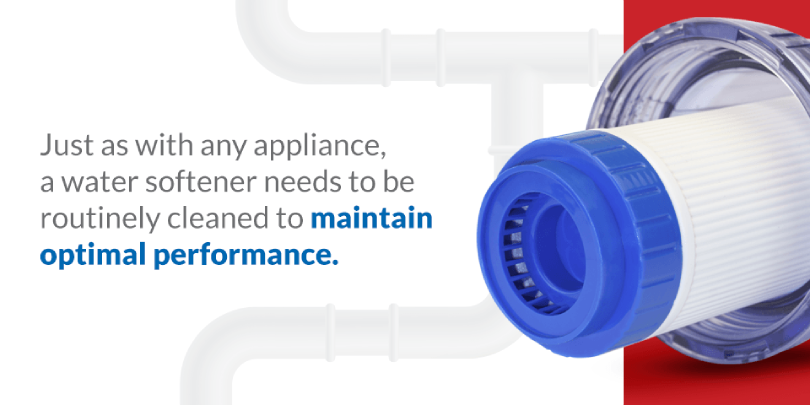
Just as with any appliance, a water softener needs to be routinely cleaned to maintain optimal performance. Under normal circumstances, you do not need to clean a water softener frequently — roughly once or twice every five years should be adequate. However, if the hardness of your output water suddenly increases or takes on a brown tint, it is probably a good idea to schedule a system cleaning.
1. Cleaning the Brine Tank
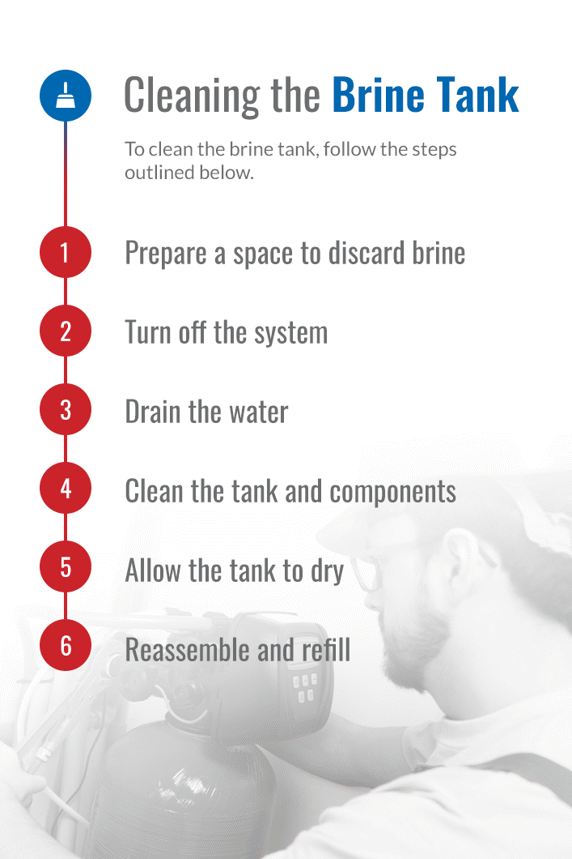
If possible, plan your cleaning strategically — how easy it will be to clean depends on how much salt is in the water softener. The best time to clean the brine tank is when it is almost empty. There are two reasons why this is helpful. First, because it contains little salt, it is much lighter than normal and easier to move. To avoid spreading water throughout your home, you will want to move the brine tank outside before you begin the cleaning process — outside, you can properly dispose of the brine as well.
Secondly, a low-level brine tank is helpful for cleaning due to increased visibility. When the salt level is low, you can see any dirt and debris at the bottom of the tank easily. As it passes through the brine tank, any dirt in the brine is embedded in the salt and accumulates over time.
To clean the brine tank, follow the steps outlined below.
- Prepare a space to discard brine: If possible, dig a shallow hole somewhere in your yard. Line the bottom with landscape cloth, gravel and sand to keep the salts and impurities from leaching into the soil.
- Turn off the system: Before removing the brine tank, turn off the system by opening the bypass valve. Disconnect any electricity that powers the water softener.
- Drain the water: Take the brine tank outside and pour the water and sludge into your prepared hole.
- Clean the tank and components: Disassemble the various parts of the brine tank. Mix water with dishwashing detergent to create a cleaning solution, and using a stiff bristle brush, scrub the inside of the tank and rinse out with water.
- Allow the tank to dry: Allow the washed brine tank and its components to dry thoroughly before reassembling. If desired, you can use a rag to dry smaller pieces, such as the brine valve.
- Reassemble and refill: Take the tank and components back into the house and reassemble it. Reconnect the tank to electricity, and refill the tank with fresh, clean salt nearly all the way to the top.
Make sure to run the softener through a full regeneration cycle once you have cleaned the brine tank — this will allow the brine tank to recalibrate and refill.
2. Cleaning the Resin Tank
Cleaning the resin tank of a water softener is typically more straightforward than cleaning the brine tank.
There are two primary methods of cleaning the resin tank — you can remove the tank and clean it manually, or you can use an iron-removing solution and rinse away any impurities with a regeneration cycle.
- Option 1: Before removing the resin tank, first make sure that the water softener is unplugged. Then unscrew the bolts, disconnect the valve and remove the tank. Clean the resin using a solution of bleach and water before reinstalling the tank. Run a regeneration cycle to flush out any remaining bleach from the system.
- Option 2: Another way to clean your resin tank is to purchase a specially designed, iron-removing product. Following the instructions on the package, pour some of the product into the tank. After giving the product time to work, begin a regeneration cycle to remove any wastewater.
By regularly cleaning the brine and resin tanks of your water softener, you will increase both its effectiveness and lifespan.
You should check your salt levels on a monthly basis to ensure you have the right amount to keep your brine tank functioning in peak condition. Neglecting this step will cause issues with your resin beads’ regeneration process and negatively affect your home’s supply of soft water.
You want to make sure your salt levels are at least half-full in your tank and reach at least three inches above the water level. More salt than water improves efficiency, though it is best to keep an eye on the tank and reduce the salt level if you notice clinging salt on the sides of it.
How Long Does a Water Softener Last?
The general life span for a water softener is anywhere between 10 and 20 years depending on the make, quality and type of tank you’re working with. You should get your tank repaired if it’s older than five years and you notice a decline in its performance, such as letting some hard water out.
If your tank is nearing 10 years and not working as effectively as it once was, you need to replace it. You should contact a technician to have a new tank installed as soon as you start encountering problems.
Maintaining your tank to extend its life span is as easy as following these guidelines:
- Avoiding overexerting the work it needs to do for your home
- Changing the filter as often as it needs
- Adding regenerant before water is visible in the brine tank
- Only replacing the salt supply before the tank is a third full
- Flushing your resin beads with water softener annually to keep them working effectively
Common Water Softener Problems
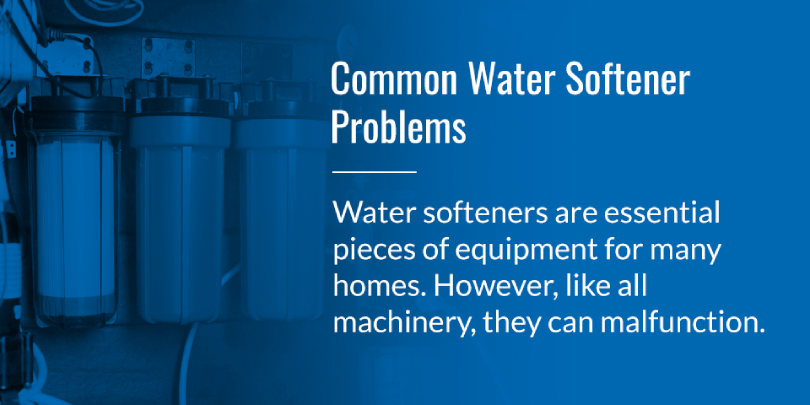
Water softeners are essential pieces of equipment for many homes. However, like all machinery, they can malfunction. Here are five of the most common problems that develop in water softeners, along with their warning signs.
1. Blockages
Blockages are one of the most common issues that develop in water softening systems.
The same is true for any system designed around a flowing substance. For example, in a typical plumbing system, calcium and magnesium can accumulate and build deposits in the pipes. The same thing happens in water softeners — salt and minerals from the brine gradually accumulate over time, blocking the line and impeding the path through the tank. Ultimately, these blockages reduce the efficiency of the entire system.
In water softeners, the two most common sites for blockages are the brine line and the filter screen. The primary sign of a blockage is a significant change in the amount of water being softened — if you notice that your softened water supply has suddenly decreased, you are probably dealing with a blockage.
2. Salt Bridges
Besides accumulating in the lines, salt deposits can build up inside the brine tank. Over time, these deposits can form salt bridges.
A salt bridge develops because of growing sodium deposits in the brine tank. As more and more salt is added to the deposit, it forms a hard crust that prevents water from getting to the bottom of the tank. This keeps the water from creating a brine, which is a critical step in the water softening process.
If you notice that your water softener is operating, but your output water is not softened, a salt bridge is the likely culprit.
3. Resin Beads
Typically, the resin beads within a water softener will last as long as the system. Occasionally, they will break or stop working at full efficiency prematurely.
There are a few signs of ineffective resin beads. The first indication could be if your water softener requires frequent recharging — the issue could lie with the resin beads. Another sign is if you notice any floating particles in the softened output water. While these particles may be debris and indicate a different problem, they may also signify a breakdown of resin beads.
If your resin beads are not functioning correctly, they may either need a simple cleaning or a full replacement. Contact a plumber you trust for an accurate recommendation.
4. Motor
A water softener relies on a working motor to function properly. However, like any piece of machinery, the motor of your system can fail.
When a water softener fails or begins to wear out, the problem is possibly related to the motor. However, before you come to any conclusions, check to make sure that all of the cables and cords are undamaged. Also, examine the breaker box — a faulty fuse could cause the whole system to shut down. If the wiring looks fine, contact your manufacturer to see if they will send a technician or a replacement motor.
5. User Error
To some degree, water softeners rely on human input and management. Different water softeners have different settings, and some models are more complex than others. Even a small change in settings could cause your water softener to malfunction.
Take the time to familiarize yourself with your water softener — read the user's manual and learn the different controls and settings. If you are not sure what is wrong with your water softener, experiment with different controls and consult the user's manual for recommended settings. If the problem persists, call a professional to examine the appliance. Although the water softener may have a serious problem, you may have simply pressed the wrong button.
How Often Do Water Softeners Need Servicing?
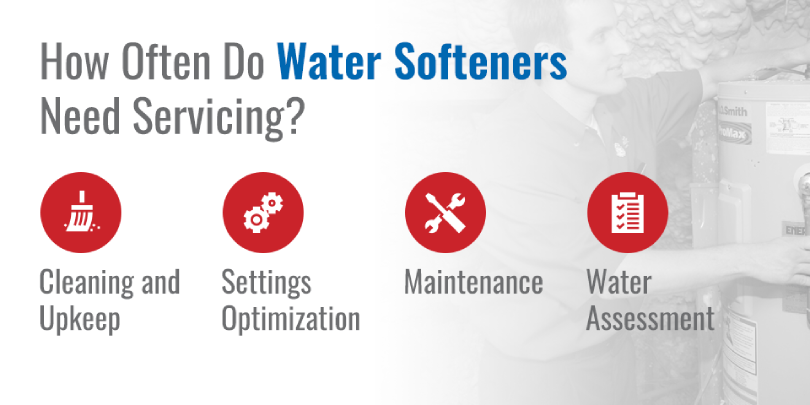
When they are properly installed, good water softeners can last for years with little maintenance. However, regular cleaning and inspections will boost the lifespan of your softener — replacing the salt, scrubbing out the brine tank and having your softener inspected annually are essential for a well-functioning system.
Beyond checking for any damages, an expert can perform several soft water system services, including cleaning the softener, optimizing its settings, conducting routine maintenance and assessing the water flowing in and out of the machine.
- Cleaning and upkeep: A water treatment professional knows the details and intricacies of water softeners, and they can provide the highest level of service so that your water softener has the longest possible lifespan. In an annual servicing call, a water treatment professional can clean out the brine tank and recharge resin beads. They will know what to look for, including salt bridges, mushing and venturi blockages.
- Settings optimization: Having your water softener annually examined by a professional ensures that all your settings will be optimized. This will save you money in the long run — a water treatment professional can work with you to find the best settings for your family's specific needs, keeping you from softening unnecessary water.
- Maintenance: Just like any piece of equipment, a water softener's components will wear out over time. During an annual maintenance check, a professional will examine all parts of your water softener, checking for any worn parts that need replacement.
- Water assessment: Besides maintaining your water softener, a water treatment professional can test your water and monitor the levels of different minerals or impurities. They can detect any changes that happen from year to year, catching a potential softener malfunction early.
When you have a water treatment professional service your water softener, you maximize its lifespan and minimize the chance of future malfunction.
Industry Experts You Can Trust
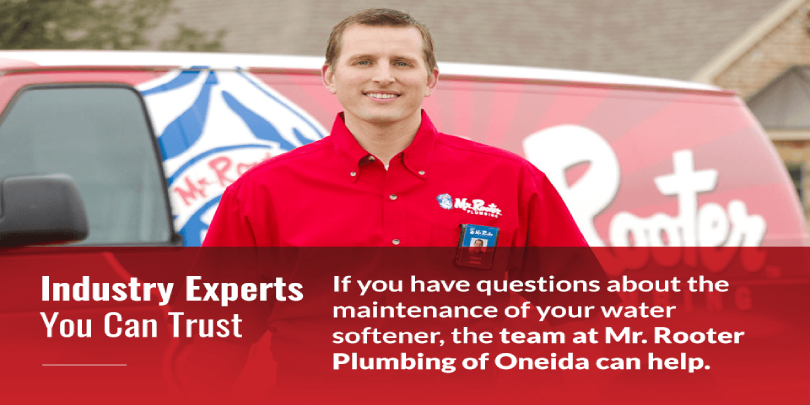
If you have questions about the maintenance of your water softener, the team at Mr. Rooter Plumbing of Oneida can help.
With nearly 50 years of experience, we are a team of industry-leading, licensed experts, and we offer the highest quality of work and exceptional customer service. If you have any water softener concerns, call Mr. Rooter Plumbing — contact us online or give us a call to talk with a representative today.
